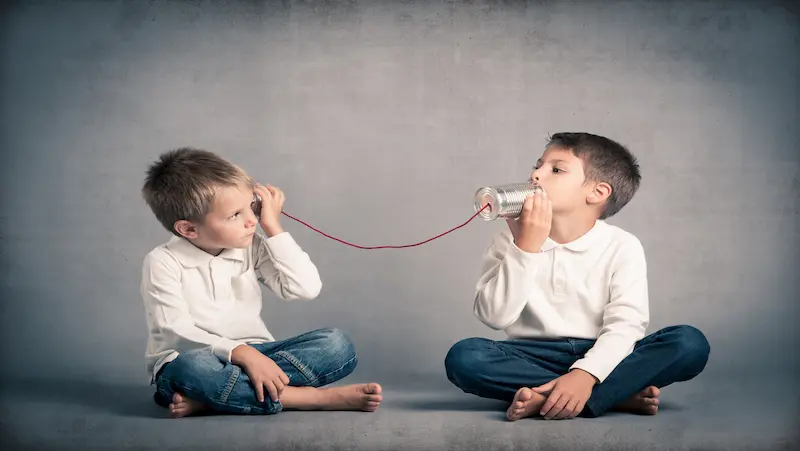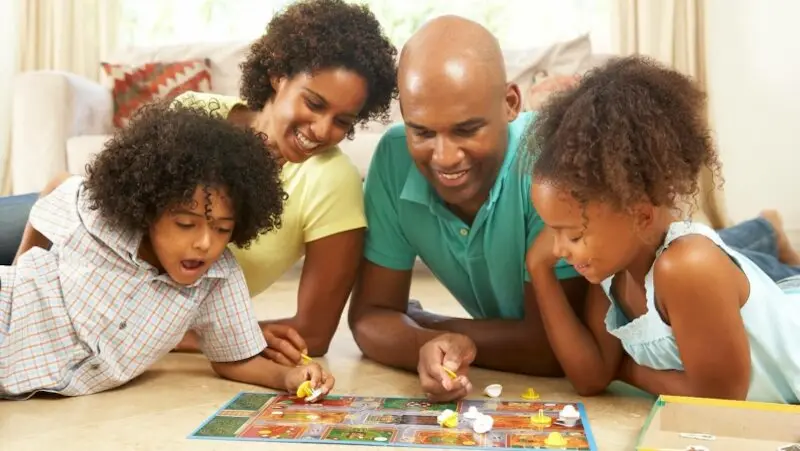In today’s fast-paced and technology-driven world, it’s becoming increasingly challenging for parents and children to maintain strong and meaningful relationships.
The importance of effective communication between parents and their children cannot be overstated, as it forms the foundation for a strong bond and healthy development. However, with the rise of digital distractions and busy schedules, many families are struggling to connect on a deep and authentic level.
This is where the need to enhance parent-child communication becomes crucial. By fostering open lines of communication, parents can establish trust, understanding, and emotional support with their children.
When children feel heard and valued, they are more likely to express their thoughts, concerns, and emotions freely, which can lead to better problem-solving, conflict resolution, and overall well-being.
Enhancing parent-child communication goes beyond simply talking to one another. It involves active listening, empathy, and creating a safe and non-judgmental space for open dialogue.
It requires parents to be present, both physically and mentally, in their children’s lives, and to prioritize quality time together. By doing so, parents can gain valuable insights into their children’s lives, interests, and challenges, fostering a deeper understanding and connection.
Table of contents
- Importance of Parent-Child Communication
- Barriers to Effective Communication
- Strategies to Improve Parent-Child Communication
- Activities to Strengthen Parent-Child Communication
- Addressing Challenging Conversations
- Promoting Positive Communication Habits
- Utilizing Technology for Communication
- Conclusion
- Frequently Asked Questions
Importance of Parent-Child Communication
Parent-child communication plays a vital role in the healthy development of children. It serves as a foundation for building trust, establishing strong connections, and nurturing emotional well-being.
Effective communication between parents and children sets the stage for positive interactions, understanding, and growth. In this blog, we will explore the significance of parent-child communication in building trust and connection, as well as its impact on emotional development and overall well-being.

Building Trust and Connection
Trust is the cornerstone of any relationship, and parent-child relationships are no exception. When parents establish open lines of communication, children feel more comfortable expressing themselves, sharing their thoughts, and seeking guidance. Regular conversations create a safe space for children to voice their concerns, fears, and joys, fostering trust and strengthening the parent-child bond.
Listening actively to children’s thoughts and feelings without judgment and responding empathetically helps build trust. By showing genuine interest and providing undivided attention, parents can make their children feel valued and understood. This trust lays the groundwork for children to approach their parents during times of need, allowing for timely support and guidance.
Communication also helps parents understand their children’s needs, interests, and aspirations. By engaging in meaningful conversations, parents can identify their child’s strengths, weaknesses, and areas where support may be required. This knowledge enables parents to provide appropriate guidance, and encouragement, and create an environment that nurtures their child’s growth and development.
Emotional Development and Well-being
Effective parent-child communication significantly impacts a child’s emotional development and overall well-being. When children feel heard and acknowledged, they develop a sense of self-worth, confidence, and emotional resilience. Engaging in open and honest conversations allows parents to help their children navigate complex emotions, understand their feelings, and develop healthy coping mechanisms.
Through communication, parents can teach their children essential skills like empathy, active listening, and conflict resolution. These skills empower children to build positive relationships, manage conflicts constructively, and express their emotions in a healthy manner. Such emotional intelligence is crucial for children’s social interactions and helps them thrive in various aspects of life, including school, friendships, and future endeavors.
Parent-child communication also plays a pivotal role in preventing and addressing mental health issues. When children have a supportive and open line of communication with their parents, they are more likely to seek help when facing emotional difficulties. This connection enables parents to notice warning signs early on and provide the necessary support, whether it be through professional assistance or simply being a compassionate listener.
Barriers to Effective Communication
Effective communication is the cornerstone of successful relationships, both personal and professional. However, various barriers can hinder the smooth flow of information, leading to misunderstandings, conflicts, and inefficient outcomes.
Two significant barriers in today’s world are age-related communication challenges and technological distractions. In this blog, we will explore these barriers in detail and discuss how they impact effective communication.

Age-Related Communication Challenges:
Age-related communication challenges refer to the difficulties that can arise when individuals from different age groups try to communicate effectively. Each generation has its unique communication styles, preferences, and cultural norms, which can create misunderstandings and hinder effective communication.
Generational Communication Styles:
Different generations, such as Baby Boomers, Generation X, Millennials, and Generation Z, have grown up in distinct socio-cultural environments, which shape their communication styles. For example, older generations may prefer face-to-face interactions and formal communication channels, while younger generations may rely more on digital communication platforms and informal language. These differences can lead to misinterpretations and communication breakdowns.
Technological Literacy:
Technological advancements have transformed the way we communicate, and younger generations are often more tech-savvy than older individuals. This technological divide can create challenges when older adults struggle to adapt to new communication technologies or are unfamiliar with digital platforms. Misunderstandings can arise when younger individuals assume everyone possesses the same level of technological proficiency.
Communication Etiquette:
Each generation has its own set of communication etiquette, influenced by societal norms and cultural values. For instance, older generations may prioritize formalities, such as addressing individuals with proper titles and using polite language. In contrast, younger generations may be more casual in their communication approach, relying on informal language and abbreviations. Failure to understand and adapt to these etiquette differences can impede effective communication.
Technological Distractions and Screen Time:
In today’s digital age, technological distractions and excessive screen time have become significant barriers to effective communication. These distractions can disrupt focus, decrease attentiveness, and hinder meaningful interactions.
Multitasking and Attention Span:
With the proliferation of smartphones and other digital devices, individuals are often tempted to multitask during conversations or meetings. Constant notifications, social media updates, and the allure of entertainment can divide attention, leading to reduced comprehension and engagement. This lack of focus undermines effective communication, as important details may be missed or misinterpreted.
Non-Verbal Cues:
Non-verbal cues, such as facial expressions, body language, and tone of voice, play a crucial role in communication. However, excessive screen time can limit face-to-face interactions and erode the ability to interpret these cues accurately. Over-reliance on digital communication platforms can result in misunderstandings and miscommunications, as important non-verbal signals may go unnoticed.
Digital Overload and Information Overload:
The constant bombardment of information from various digital sources can overwhelm individuals and lead to information overload. When communication channels are saturated with excessive data, it becomes challenging to filter out relevant information and focus on meaningful interactions. This can hinder effective communication, as important messages may get lost in the noise of overwhelming information.
Strategies to Improve Parent-Child Communication
Effective communication is the foundation of a strong and healthy parent-child relationship. When parents and children can openly express their thoughts, feelings, and concerns, it creates a supportive environment where trust and understanding flourish. In this blog, we will explore four essential strategies that can significantly enhance parent-child communication.

Active Listening Techniques
Active listening is a crucial skill that allows parents to connect with their children on a deeper level. It involves not only hearing what your child is saying but also paying attention to their emotions, body language, and unspoken messages. Here are some active listening techniques that can foster better communication:
Empathetic Listening: Put yourself in your child’s shoes and try to understand their perspective without judgment. Show empathy and validate their emotions, even if you don’t necessarily agree with their point of view.
Maintain Eye Contact: Eye contact shows your child that you are fully engaged in the conversation and genuinely interested in what they have to say.
Reflective Responses: After your child has expressed themselves, paraphrase their words back to them to ensure you understand correctly. This demonstrates that you are actively listening and helps clarify any misunderstandings.
Avoid Interrupting: Give your child the space to express themselves fully without interruption. Interrupting can make them feel unheard and discourage open communication.
Encouraging Open and Honest Conversations
Creating an atmosphere where open and honest conversations are welcomed is essential for parent-child communication. Children should feel comfortable sharing their thoughts and feelings without fear of judgment or punishment. Here’s how you can foster such an environment:
Build Trust: Trust is the cornerstone of open communication. Be honest, reliable, and keep your promises to earn your child’s trust.
Be Approachable: Let your child know that they can talk to you about anything without facing negative consequences. Avoid reacting impulsively or angrily when they share something with you.
Avoid Criticism: When discussing sensitive topics, refrain from criticizing or blaming your child. Instead, focus on finding solutions together.
Ask Open-Ended Questions: Encourage deeper conversations by asking open-ended questions that require more than a simple “yes” or “no” response.
Setting Aside Quality Time for Communication
In today’s busy world, finding quality time to communicate with your child might be challenging, but it’s crucial for building a strong bond. Make an effort to create dedicated time for one-on-one conversations:
Family Meetings: Schedule regular family meetings where everyone can share their thoughts and feelings. Make it a positive and inclusive experience.
Mealtime Conversations: Use mealtime as an opportunity for casual conversations. Create a relaxed atmosphere where everyone can share their day.
Bedtime Talks: Bedtime can be a great moment for quiet conversations and reflection. Use this time to connect with your child on a more intimate level.
Non-Verbal Communication Cues
Non-verbal cues play a significant role in communication and can either support or hinder the effectiveness of verbal messages. Pay attention to your non-verbal cues and be mindful of how they might impact your child’s perception:
Body Language: Maintain an open posture and use affirmative gestures like nodding to show that you are listening and understanding.
Facial Expressions: Your facial expressions can convey a lot of information. Show interest and concern with a warm and attentive expression.
The tone of Voice: Be aware of your tone when speaking with your child. A calm and gentle tone can help create a positive atmosphere for communication.
Activities to Strengthen Parent-Child Communication
Parent-child communication is the foundation of a healthy and strong relationship. By engaging in activities that foster communication, parents can create a nurturing environment where their children feel heard, valued, and understood.
In this blog post, we will explore four activities that can help strengthen parent-child communication: storytelling and reading together, family game nights, engaging in art and creative projects, and outdoor activities and nature exploration. Let’s dive in!

Storytelling and Reading Together
Storytelling and reading together are wonderful ways to bond with your child while also fostering their language and imagination skills. Whether you choose to read a book aloud or create your own stories, this activity provides an opportunity for open dialogue and shared experiences.
Encourage your child to ask questions, share their thoughts and feelings, and even create their own endings or characters. By engaging in storytelling and reading together, you create a safe space for your child to express themselves and for you to listen and understand their perspectives.
Family Game Nights
Family game nights not only promote healthy competition and problem-solving skills but also provide a platform for communication and laughter. Choose games that require interaction and teamwork, such as board games or card games.
During game nights, encourage your child to express their strategies, listen to their ideas, and celebrate their achievements. Engaging in friendly competition can also teach valuable life lessons about sportsmanship, empathy, and resilience. The key is to create an inclusive and enjoyable environment that encourages open communication among family members.
Engaging in Art and Creative Projects
Art and creative projects offer a unique way for children to express themselves and for parents to engage in meaningful conversations. Set aside dedicated time for artistic exploration, such as drawing, painting, crafting, or even writing stories or poems.
Encourage your child to share their creations, discuss the inspiration behind their artwork, and ask questions to understand their perspective. By fostering a non-judgmental and supportive atmosphere, you allow your child’s creativity to flourish, and in turn, strengthen your connection through shared experiences.
Outdoor Activities and Nature Exploration
Nature provides a beautiful backdrop for meaningful conversations and shared experiences. Engaging in outdoor activities and nature exploration with your child allows you both to disconnect from technology and immerse yourselves in the wonders of the natural world.
Take hikes, visit parks, go camping, or simply spend time in your backyard. Encourage your child to observe their surroundings, ask questions about plants and animals, and share their thoughts and feelings. This activity not only promotes communication but also instills a sense of appreciation and stewardship for the environment.
Addressing Challenging Conversations
Life is full of challenges and transitions that can be difficult to navigate, especially when it comes to having conversations about them. Whether it’s discussing sensitive topics like bullying and peer pressure or facing major life changes such as divorce or moving, engaging in open and effective communication is key. In this blog, we will explore strategies and approaches to help address these challenging conversations with empathy, understanding, and resilience.

Talking About Difficult Topics:
Create a Safe and Non-Judgmental Space:
When discussing sensitive topics like bullying and peer pressure, it’s crucial to establish a safe and non-judgmental environment. Encourage open dialogue by assuring the person involved that their feelings and experiences are valid and that you are there to listen without judgment. Active listening and empathy play vital roles in fostering trust and making the conversation productive.
Choose the Right Time and Place:
Timing and setting can greatly impact the effectiveness of challenging conversations. Pick a time when both parties are calm and ready to engage in a thoughtful discussion. Find a private and comfortable space that allows for undisturbed conversation. Avoid having these conversations in public or when either party is feeling overwhelmed or distracted.
Be a Supportive Listener:
Listening attentively is crucial during difficult conversations. Encourage the person to share their thoughts, emotions, and concerns. Show genuine interest by maintaining eye contact, nodding, and using verbal cues to let them know you are actively engaged. Refrain from interrupting or offering unsolicited advice unless specifically asked for.
Validate and Empathize:
Validate the person’s feelings and experiences by acknowledging their emotions. Let them know that you understand the difficulty of their situation and empathize with what they are going through. Avoid belittling or dismissing their experiences, as it can further discourage open communication. Validating their feelings helps create a foundation of trust and support.
Collaborate on Problem-Solving:
Approach the conversation as a collaborative effort to find solutions or strategies together. Encourage brainstorming and exploring various options to address the issue at hand. Help the person identify their strengths and resources they can draw upon. By involving them in the problem-solving process, you empower them to take ownership and build resilience.
Navigating Changes and Transitions:
Acknowledge Emotions and Provide Reassurance:
Major life changes such as divorce or moving can evoke a range of emotions. Acknowledge the person’s feelings and provide reassurance that it’s normal to experience a mix of emotions during transitions. Let them know that you are there to support them throughout the process.
Encourage Open Communication:
Transitions can be overwhelming, and individuals may find it challenging to express their thoughts and concerns. Encourage open communication by actively asking how they are feeling and providing a safe space for them to share. Assure them that their thoughts and emotions are valid and that you are ready to listen without judgment.
Help Identify Coping Strategies:
Discuss coping strategies that can help the person navigate the challenges associated with the transition. Encourage them to explore healthy ways of coping, such as journaling, exercising, seeking support from friends or professionals, or engaging in activities they enjoy. Remind them that it’s okay to ask for help and that they don’t have to face these changes alone.
Focus on Resilience and Adaptability:
Transitions often require individuals to adapt to new circumstances. Highlight their past successes and strengths to instill confidence in their ability to handle the challenges ahead. Emphasize that change can also bring new opportunities for personal growth and development. Encourage them to embrace the journey and view it as a chance to learn and thrive.
Seek Professional Support if Needed:
Sometimes, challenging life transitions may require professional guidance and support. If the person is struggling to cope or their well-being is significantly impacted, suggest seeking help from therapists, counselors, or support groups specializing in the specific challenges they are facing. Professional support can provide valuable tools and resources to navigate the transition effectively.
Promoting Positive Communication Habits
In today’s fast-paced and interconnected world, effective communication is more important than ever. It not only helps us convey our thoughts and feelings, but it also plays a crucial role in building and maintaining strong relationships. However, communication can sometimes be challenging, leading to misunderstandings, conflicts, and strained connections.
By cultivating positive communication habits, we can create a more harmonious and fulfilling environment in our personal and professional lives. In this blog post, we will explore four key strategies for promoting positive communication habits: modeling healthy communication behavior, praising and encouraging effort, providing constructive feedback, and resolving conflicts peacefully.

Modeling Healthy Communication Behavior
One of the most powerful ways to promote positive communication is through modeling healthy behavior. People learn by observing those around them, so it’s essential to be mindful of our own communication habits.
By demonstrating active listening, respect, empathy, and clear expression of thoughts and emotions, we set a positive example for others to follow. When we prioritize open and honest communication, we encourage others to do the same, creating a culture of understanding and trust.
Praising and Encouraging Effort
Positive reinforcement is a powerful tool in shaping behavior. When we recognize and praise others for their communication efforts, we not only boost their confidence but also reinforce the habit of effective communication.
Whether it’s a co-worker who articulates their ideas well in a meeting or a partner who expresses their emotions openly, acknowledging and appreciating their efforts can go a long way. By focusing on the positives, we create an environment that encourages continuous growth and improvement in communication skills.
Providing Constructive Feedback
Constructive feedback is crucial for personal and professional growth. When done effectively, it can strengthen relationships and improve communication skills. When offering feedback, it’s essential to be specific, objective, and supportive.
Instead of criticizing or blaming, focus on the behavior or issue at hand and offer suggestions for improvement. By providing constructive feedback, we help others become more self-aware and empower them to enhance their communication abilities.
Resolving Conflicts Peacefully
Conflict is inevitable in any relationship, but how we handle it determines its impact on our connections. Instead of resorting to aggression or avoidance, strive for a peaceful resolution. Start by actively listening to the other person’s perspective and seeking to understand their point of view.
Communicate your thoughts and feelings calmly and respectfully, using “I” statements to express yourself without placing blame. Find common ground and work together to find a mutually agreeable solution. Remember, conflicts can be opportunities for growth and deeper understanding if approached with open-mindedness and a willingness to compromise.
Utilizing Technology for Communication
In today’s digital age, technology has revolutionized the way we communicate, making it faster, more convenient, and accessible than ever before. From smartphones to social media platforms, the possibilities for connecting with others seem endless.
However, as we embrace these technological advancements, it becomes essential to strike a balance between screen time and face-to-face interaction. This blog explores the importance of maintaining this balance and suggests various apps and tools that can facilitate effective communication.

Know more about code for kids
Balancing Screen Time and Face-to-Face Interaction:
Prioritizing Face-to-Face Interaction:
While technology offers numerous avenues for communication, it should not replace the value of face-to-face interaction. Engaging in in-person conversations helps build deeper connections, fosters empathy, and enhances non-verbal communication skills. It’s crucial to make time for meaningful interactions with family, friends, and colleagues offline.
Setting Boundaries:
With the abundance of digital distractions, setting boundaries around screen time is vital. Allocate specific periods in your day to disconnect from devices and engage in activities that require your undivided attention. This could include pursuing hobbies, exercising, or spending quality time with loved ones. By doing so, you create space for meaningful interactions without constant digital interruptions.
Active Listening:
In our fast-paced digital world, we often find ourselves multitasking during virtual conversations. However, active listening is a vital aspect of effective communication. Whether face-to-face or through technology, practice active listening by giving your undivided attention, maintaining eye contact, and being fully present in the conversation. This fosters a deeper understanding and connection with the person you’re communicating with.
Using Apps and Tools to Facilitate Communication:
Video Conferencing Tools:
Video conferencing platforms like Zoom, Microsoft Teams, and Google Meet have become indispensable for both personal and professional communication. These tools allow face-to-face interactions regardless of geographical barriers, making them ideal for remote work, connecting with distant friends and family, or collaborating on projects.
Instant Messaging Apps:
Instant messaging apps such as WhatsApp, Slack, or Telegram offer quick and convenient communication channels. They enable real-time conversations, group chats, and the exchange of multimedia files. These apps are useful for staying connected with friends, coordinating team projects, or discussing ideas with like-minded individuals.
Social Media:
Social media platforms like Facebook, Twitter, and Instagram offer unique opportunities for communication and networking. They allow you to connect with a broader audience, share ideas, and engage in meaningful discussions. However, it’s important to use social media mindfully, avoiding excessive screen time and prioritizing genuine interactions over superficial engagement.
Collaboration Tools:
Collaboration tools like Google Drive, Trello, or Asana facilitate seamless communication and teamwork. These platforms enable users to collaborate on documents, assign tasks, and track progress. By utilizing such tools, you can enhance communication within teams, streamline workflows, and increase productivity.
Explore more about best robotics for kids here
Conclusion
In conclusion, enhancing parent-child communication is essential for building a stronger bond between parents and their children. Effective communication serves as the foundation for trust, understanding, and emotional connection within the family unit.
In conclusion, enhancing parent-child communication requires conscious effort and a commitment to fostering an environment of trust, understanding, and open dialogue. By actively listening, creating a safe space, dedicating quality time, and leveraging appropriate technology, parents can significantly strengthen their bond with their children.
The benefits of enhanced communication extend beyond the parent-child relationship, positively impacting the child’s emotional well-being, self-esteem, and overall development. Investing in effective communication today will contribute to healthier, more fulfilling relationships between parents and their children in the long run. Learn about coding for kids also.
Also, BrightChamps provides a comprehensive platform for learning about money for kids, offering interactive and engaging resources that teach financial literacy, budgeting, saving, and other essential money management skills.
Frequently Asked Questions
A1. Spend quality time together, actively listen, and show empathy to enhance communication and strengthen your bond with your child.
A2. Be present, set aside dedicated time for conversations, use open-ended questions, and validate your child’s feelings for better parent-child communication.
A3. Effective communication builds trust, understanding, and emotional connection, forming a solid foundation for a strong parent-child bond.
A4. Active listening demonstrates interest, understanding, and respect, fostering meaningful parent-child communication by encouraging your child to express themselves fully.
A5. Common communication barriers include a lack of active listening, generational differences, and power imbalances. Overcome them through patience, empathy, and seeking common ground.
A6. Non-verbal cues like eye contact, body language, and gestures convey warmth, support, and understanding, contributing to a deeper parent-child bond.
A7. Communication techniques like active listening, reflective responses, and using positive reinforcement can foster a deeper connection and understanding with your child.
A8. Empathy plays a crucial role in parent-child communication by validating emotions and perspectives. Cultivate empathy by actively putting yourself in your child’s shoes and responding with understanding.
A9. Create a safe and supportive environment by promoting open dialogue, respecting boundaries, and validating your child’s thoughts and feelings without judgment.
A10. Activities like storytelling, arts and crafts, and family game nights can facilitate communication and bonding between parents and children.


 We are an army of educators and passionate learners from BrightChamps family, committed to providing free learning resources to kids, parents & students.
We are an army of educators and passionate learners from BrightChamps family, committed to providing free learning resources to kids, parents & students.







